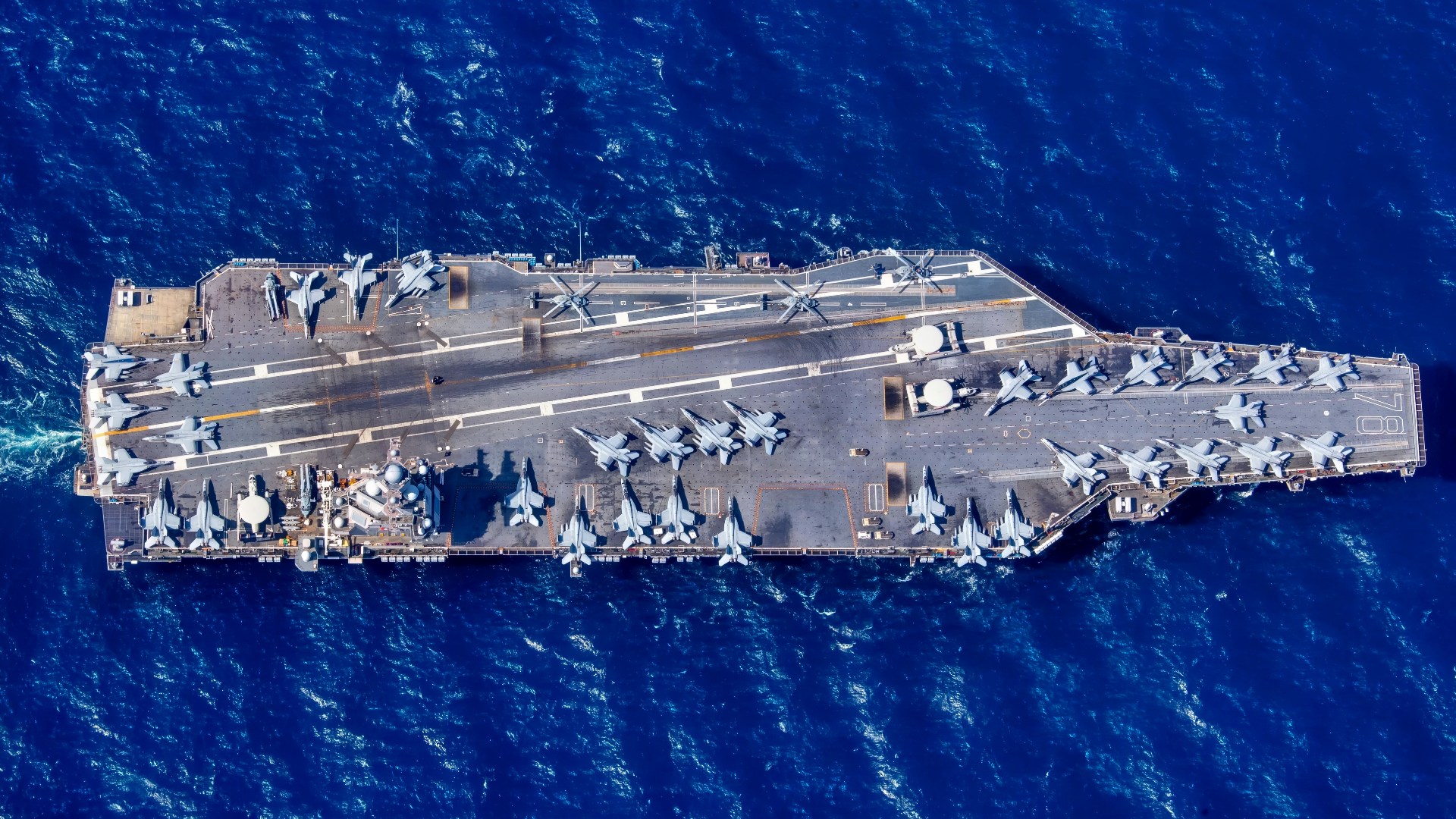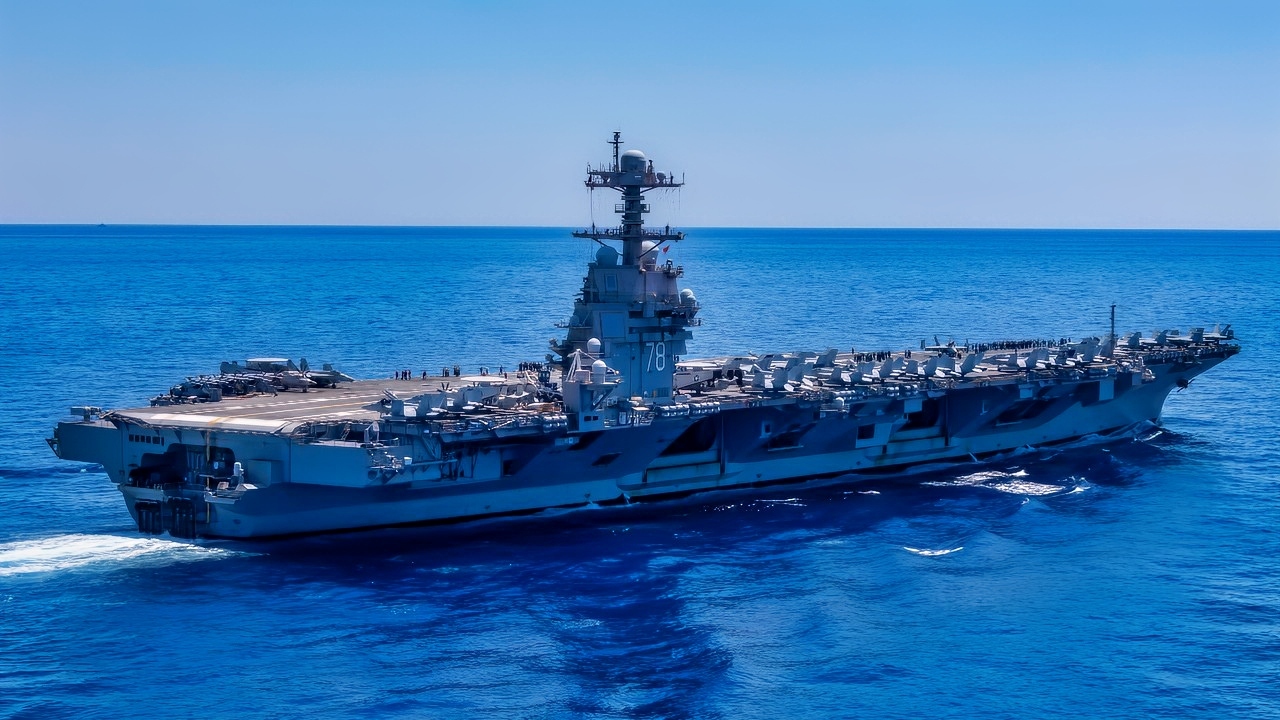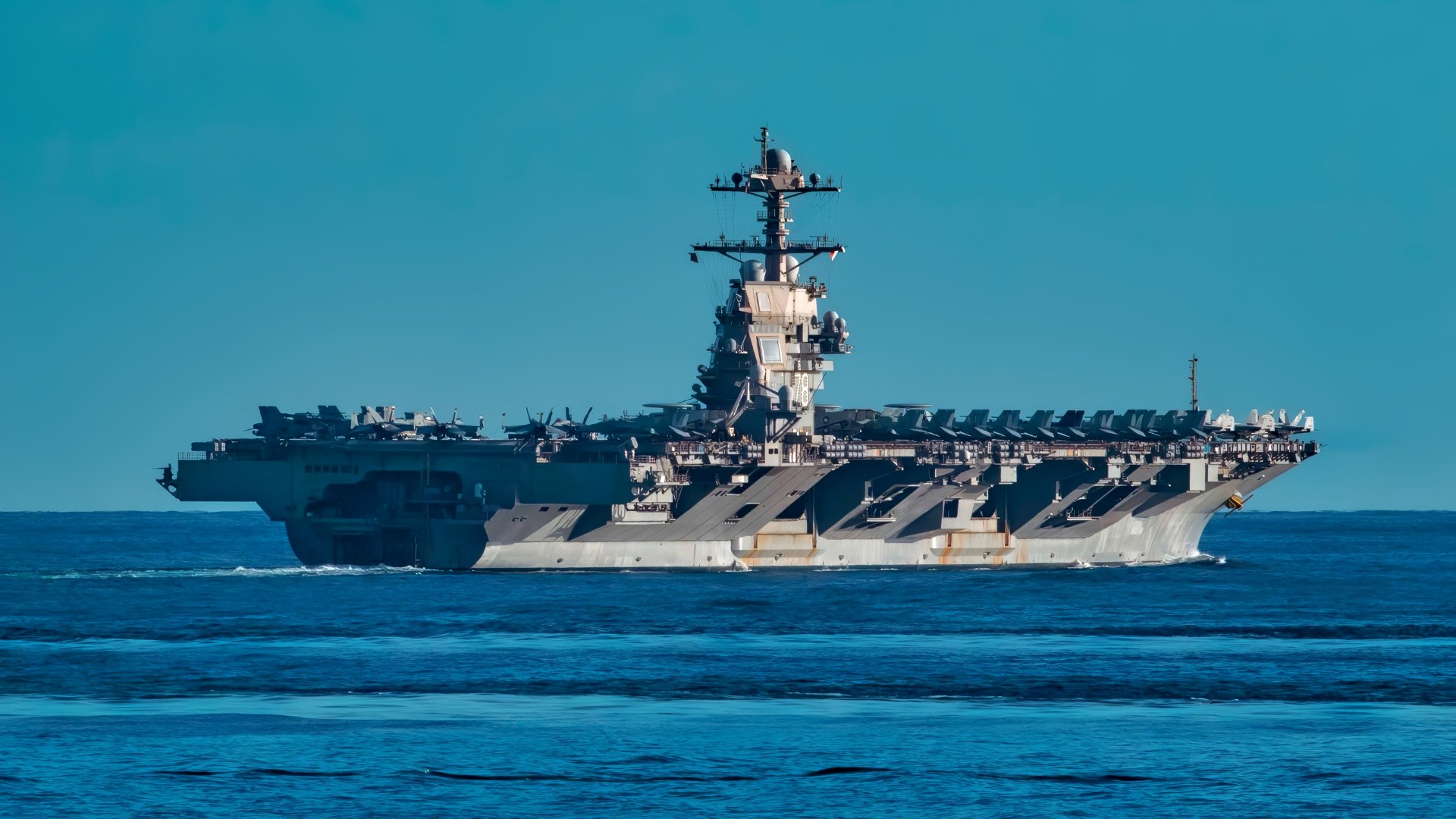Key Points and Summary – A U.S. aircraft carrier strike group, likely to be soon near Venezuela, is neither a token counternarcotics gesture nor a prelude to invasion. It’s compellence: calibrated military pressure to force behavioral change and reassert a U.S. sphere of influence in the Western Hemisphere.
-The move signals hierarchy and escalation dominance to Caracas and its extra-regional patrons while stopping short of regime change.

The first-in-class aircraft carrier USS Gerald R. Ford (CVN 78) transits the Atlantic Ocean, March 19, 2023. Ford is underway in the Atlantic Ocean executing its Composite Training Unit Exercise (COMPTUEX), an intense, multi-week exercise designed to fully integrate a carrier strike group as a cohesive, multi-mission fighting force and to test their ability to carry out sustained combat operations from the sea. As the first-in-class ship of Ford-class aircraft carriers, CVN 78 represents a generational leap in the U.S. Navy’s capacity to project power on a global scale. (U.S. Navy photo by Mass Communication Specialist 2nd Class Jackson Adkins)
-More broadly, it reflects Washington’s shift from passive deterrence to active boundary management amid multipolar rivalry—echoed in Europe and the Indo-Pacific.
-Success hinges on credibility and restraint: persuading under pressure, enforcing limits without overreach, and restoring a regional equilibrium long assumed but seldom spelled out.
Donald Trump Has a Plan for Venezuela
The recent U.S. decision to deploy a carrier strike group to the Caribbean signifies a shift in Washington’s policy toward Venezuela—and the Western Hemisphere more broadly.
On the one hand, the U.S. government has cast the buildup as part of an interagency “counternarcotics mission” designed to counteract smuggling routes and cartels that operate with Maduro’s consent and support. On the other hand, many critics of the administration have seized upon the buildup as evidence of a creeping regime-change policy or even invasion plans. Both interpretations, however, have been misleading.
The size and character of the force speak volumes.
What Is Happening?
A carrier strike group, with its guided-missile destroyers, naval aviation forces, and forward-deployed special operations units, is a massively potent instrument of military power. Its deployment, especially so close to Venezuelan shores, sends a signal that goes well beyond that needed to interdict smugglers. At the same time, it is not nearly enough to effect regime change or an invasion. Its strategic position and operational posture leave little room for doubt: This is no bloodless demonstration of force. The move is calibrated for compellence.
It is designed to make Caracas change its ways.
The United States is using credible and significant military force to compel the Venezuelan government to rein in its behavior, to accept the limits of its autonomy, and to act in a manner befitting a country within the U.S. sphere of influence.
Considered in this light, the deployment is not a tactical move but part of a larger policing strategy for that sphere of influence.
In its classic formulation, a sphere of influence is a geographically defined area within which a dominant outside power seeks to constrain the political independence of weaker countries and to deny other powers the exercise of comparable influence.

The world’s largest aircraft carrier, USS Gerald R. Ford (CVN 78) transits the Mediterranean Sea, August 1, 2025. Gerald R. Ford, a first-in-class nuclear aircraft carrier and deployed flagship of Carrier Strike Group Twelve, is on a scheduled deployment in the U.S. 6th Fleet area of operations to support the warfighting effectiveness, lethality, and readiness of U.S. Naval Forces Europe-Africa, and defend U.S., Allied, and partner interests in the region. (U.S. Navy photo by Mass Communication Specialist Seaman Brianna Barnett)
The arrangement is distinct from, and more encompassing than, either direct control or mere alliance.
Within such a space, the dominant state expects deference in those areas it deems vital and enforces that expectation through a calibrated mix of suasion, inducements, and, when all else fails, compellence. The deployment of forces off Venezuela’s coast is precisely in that mold. It is both a proportional and unmistakable expression of hierarchy backed by the threat of escalation.
Washington is not sending these forces to oust the Maduro regime or to occupy Venezuelan territory.
Instead, it is sending a message to the government in Caracas, as well as to its external backers and patrons, that the political conduct of states in the Caribbean and Latin America is — and remains — an American concern. Venezuela has become a flash point because it has challenged the limits of that largely unwritten order. Over the last decade, the regime has taken in billions of dollars in Chinese infrastructure loans, Russian arms and security cooperation, and Iranian technical assistance and intelligence support. Each of these partnerships is a potential vector of rival influence into an area that Washington has for generations regarded as its own sphere. By dispatching a carrier strike group into striking distance of Caracas, the U.S. government is signaling that Venezuela’s flirtation with geopolitical pluralism has gone far enough.
The Strategy
This is compellence both as an idea and as a strategy. Deterrence is about preventing an adversary from taking an action. Compellence is about reversing or constraining action already in progress. It is persuasion under pressure. The object is less destructive than the acceptance of a particular hierarchy of preferences.
Success depends less on the size of the military toolbox than on credibility: the adversary’s conviction that defiance will be costly and that accommodation will be a route to relief. The carrier strike group is the physical embodiment of that logic. Its composition—naval aviation, precision-strike platforms, amphibious capabilities—signals a capacity not for limited interdiction but for escalation dominance. Continued defiance will be met with increased pressure; alignment with external powers will be met with external pressure; restraint will be met with relief.
The operation is thus also an index of a larger evolution in American statecraft. As the post–Cold War order gives way to multipolar great-power competition, Washington is relearning a grammar of statecraft that it had long since discarded. For most of the post–Cold War era, globalization was taken as a kind of substitute for geography. Washington no longer defined or defended a sphere of influence in the Western Hemisphere because it believed that economic interdependence had rendered such an approach anachronistic.
Washington misread globalization as de-territorialization. Yet competitive powers proved more than willing to exploit the very interdependencies Washington had once considered the guarantors of its primacy. China is using infrastructure, finance, and trade to extract political rents.
Russia is using arms and energy for the same end. Iran has gone back to a century-old playbook of ideologically tinted, cross-border proxies and covert networks. In turn, the United States is now relearning that old geometry of power: the need to define, and defend, and, where necessary, police the boundary of its own sphere. The carrier strike group off the coast of Venezuela is one expression of that rediscovery.
In this sense, the Caribbean is both a test case and a signal. It signals that Washington once again intends to manage its near abroad —the space closest to its shores —more actively than in the past.
It is not trying to dominate Latin America directly. Instead, the United States is reasserting a kind of regional equilibrium that once was taken for granted: an equilibrium in which regional countries remained nominally sovereign but substantively deferential, and extra-hemispheric powers recognized the limits of their reach.
As such, the operation in Venezuela is both a deterrent to outsiders and a reminder to Washington’s neighbors.
The same logic of compellence and boundary enforcement now defines the American posture elsewhere in the world. In Europe, Washington’s support for Ukraine is not about dismembering Russia’s sphere of influence but about constraining its expression within established and accepted limits.
In the Indo-Pacific, its rearmament of alliances, basing agreements, and the development of a maritime deterrence framework aim to compel China to act within a boundary consistent with regional stability. In each of these theaters, the United States is moving from passive deterrence to active management—a strategic posture appropriate to the reemergence of spheres of influence as the defining fact of world politics.
Active management, however, requires a degree of restraint as well as strength. For compellence is not about meting out punishment for its own sake.
It is about managing other states’ behavior within a stable, hierarchically ordered structure. The U.S. buildup in the Caribbean is not an act of improvisation or a return to gunboat diplomacy.
It is an exercise in boundary management—coercive, precise, and limited in both scope and aim. Washington is not seeking to overthrow regimes or absorb territory. It is seeking to restore an order in which the Western Hemisphere is, in practice if not in name, a U.S. sphere of influence.
Critics of the decision will call this regression, a return to the nineteenth-century logic of spheres of influence. In reality, it is the reemergence of the world’s natural equilibrium after a brief unipolar interlude.
In a competitive multipolar system, stability will depend on the clear delineation of power and the credible, consistent enforcement of its boundaries. The U.S. carrier strike group off Venezuela, in that sense, is not a symbol of American overreach but of renewed realism, the demonstration of a willingness and capability to compel recognition of its sphere and to deter rivals from encroaching on it.
What we are witnessing in the Caribbean is not the sideshow but a potential turning point in American strategy. It is neither the muscular overreaction that a counter-narcotics operation would suggest nor the evidence of an impending regime-change operation many believe it to be. It is, instead, that middle ground between which is just right for compellence.
What Happens Next?
It is the employment of limited but credible military power designed to remind the world that the Western Hemisphere, whether in name or in practice, remains Washington’s sphere of influence. And in a world that is once again being organized around competing centers of power, that reminder may be the most consequential signal of all.
About the Author: Dr. Andrew Latham
Andrew Latham is a non-resident fellow at Defense Priorities and a professor of international relations and political theory at Macalester College in Saint Paul, MN. You can follow him on X: @aakatham. He writes a daily column for the National Security Journal.
More Military
The British Army’s Big Challenger 3 Tank Mistake Still Stings
F-35 Stealth Fighter Program Has Passed the Point of No Return
The Iowa-Class Battleships Have A Message for Any Navy on Earth
Canada Has a Big Message for the Eurofighter Typhoon
The Mach 2 F-16 Fighting Falcon Fighter Has a Message for the U.S. Air Force











Jim
November 3, 2025 at 6:35 pm
All the reasonable principles, objectives and goals outlined in the article take balance, patience, and a certain amount of touch and political dexterity to execute over time backed with firm resolve (and military force, if necessary).
The forces assembled are not nearly enough to effect regime change or an invasion.
I agree. I hope Donald Trump recognizes that… sometimes it’s hard to tell… and know what advice he’s being told.
What can Caracas do to change its ways?
It’s hard for Caracas to renounce Chinese & Russian contact directly in the face of a force which borders on invasion capable (but again, I submit it comes up short of invasion capable, mostly to do with geography, Caracas sits 3,000 feet in elevation, fifteen miles from the coast up an exposed highway).
If there is purpose beyond regime change (which only would be achieved by military occupation of Caracas, I submit), I hope the required actions are communicated to the government of Venezuela via whatever backchannel is available for such purposes.
Reports have it, Venezuela has already offered preferential access to American oil, gas, and mineral interests and… well, it’s hard to know what else Trump wants… short of regime change… that’s what everybody wants to know… and when.
… meanwhile voices in Congress say Maduro must go.
Hard to know what the end outcome is… but those forces off Venezuela’s coast have a self-life.
They can’t stay out there indefinitely.
Something’s going to happen.